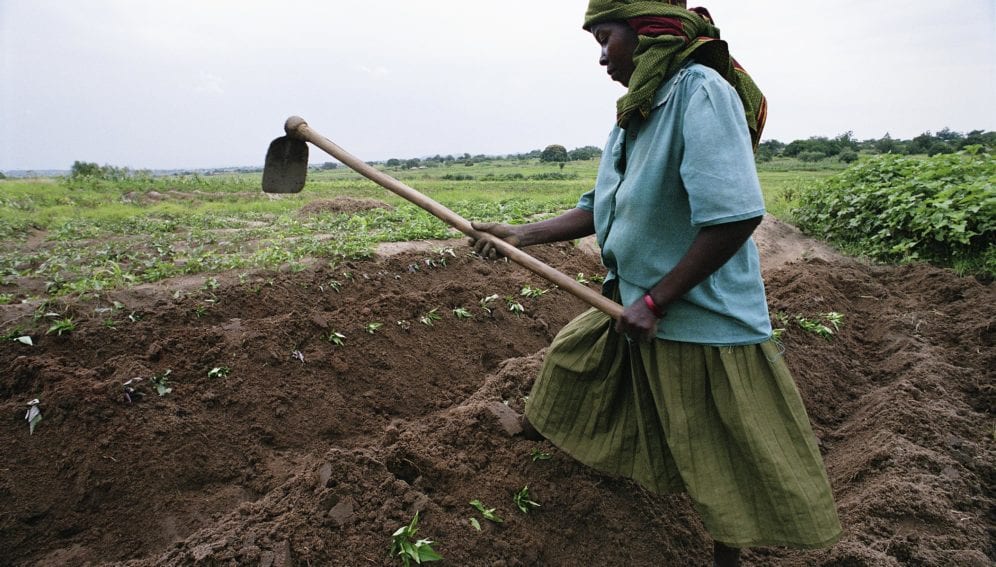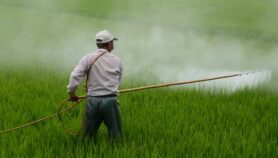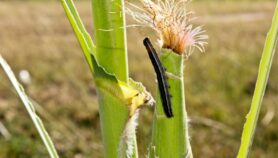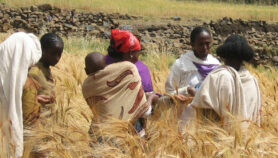09/03/20
Training and low-cost tech cut aflatoxin by 53 per cent

By: Vivian Hoffmann
Send to a friend
The details you provide on this page will not be used to send unsolicited email, and will not be sold to a 3rd party. See privacy policy.
Aflatoxin is a common fungal toxin that poses a significant threat to health and economic growth in many developing countries. It is a challenge in Africa, especially in maize and groundnut, which are grown for sale and home consumption by millions of farmers.
Chronic exposure can lead to liver cancer and has been linked to stunting while acute exposure results in hepatitis, sometimes leading to liver failure and death.
While contamination with the fungus that produces aflatoxin can begin while plants are growing in the fields, much of the risk occurs during post-harvest when handling and storage practices can expose crops to vulnerabilities. Moreover, once crops are contaminated, it is difficult to destroy the toxin.
Technologies for decontamination such as ozonation, gamma-radiation, and degradation by bacteria and yeast show promise but are not yet available at scale.
Thus, prevention is critical for both health and economic reasons. But training and access to low-cost tools for farmers to use while drying and storing their maize, such as plastic sheeting could reduce the negative effect of aflatoxin.
“Much of the risk occurs post-harvest, when handling and storage practices can expose crops to vulnerabilities.”
Vivian Hoffmann, International Food Policy Research Institute
Farmers in Africa often dry their crops on used storage bags, stitched together into sheets. As this material is permeable and difficult to clean, it can harbour spores of the fungus that produces aflatoxin.
Impermeable plastic sheeting that does not allow fluid to pass through is available in most countries, and low-cost at around 30 US cents per meter squared. But since farmers aren’t generally aware of the benefits of drying on an impermeable surface, and also because reusing old bags is nearly costless, the use of this technology is very low.
An experiment in Kenya
To better understand how to help farmers improve their practices and preserve their crops, we conducted an experimental study with maize farmers in Kenya.
We worked with 30 villages in Meru and Tharaka-Nithi counties, a part of Kenya where aflatoxin contamination in the maize crop leads to frequent, and sometimes fatal, outbreaks of aflatoxicosis: a condition that results from eating food contaminated with aflatoxins.
We worked with nearly 700 households, all of which included either a pregnant woman or a child under two years old. After villages were randomly assigned to intervention and control groups, the study team visited 15 study villages assigned to the intervention group prior to the maize harvest and provided households with training and materials that they could use to improve their post-harvest handling of maize.
The training described better postharvest handling and storing of maize. This included both information on the risks of mishandling, and strategies to prevent aflatoxin growth. We discussed why farmers should prevent contact between the harvested crop and the ground, and also explained drying and shelling techniques and the importance of storing crops in clean bags off the ground.
We provided free plastic drying sheets to all who attended training. Also, some farmers were randomly selected to receive a hermetic storage bag – an airtight bag that kills insect pests through suffocation – and or the opportunity to purchase such bags.
Depending on a random draw, farmers paid the full cost of 220 Kenyan shillings (about US$2.2 per bag, or just 95 US cents per bag.
Use of a mobile maize dryer prototype – a machine that passes air heated by burning maize cobs through the grain to dry it within a few hours rather than the several days usually required – was also offered. The cost to farmers was US$3.50, US$1.50 or free of charge, and depended, like that of the hermetic bags, on a random draw.
A subset of farmers would also receive a premium of about 50 per cent above the prevailing market price for up to 45 kilograms of their crop if it conformed to national standards three months after the harvest. Few farmers actually sold at this price because of a poor harvest in the study season.
Impact of training
We found that farmers who had access to the training, the plastic sheeting, and the other technologies saw aflatoxin contamination significantly reduced aflatoxin contamination by 53 per cent three months after harvest.
Moreover, those who received training and used the plastic sheeting alone had aflatoxin levels 79 per cent lower than those who only received training. What is particularly striking about this is the relatively low cost involved in achieving this result: plastic sheeting costs US$5 per farmer. Training including everything from materials to paying the trainer, costs about US$1.70 per farmer.
Cost-effectiveness analysis based on this study with my colleague Kelly Jones found that this translates to a cost per year of healthy life saved through provision of tarpaulin sheet and training of around US$1,300. This estimated health benefit does not include potential effects on child stunting, which could be significant.
More research needed
While results from this study are promising, it reached an admittedly small number of villages. We found similar results through a separate study we conducted in Northern Ghana.
We are currently working to scale up the study in Ghana through partnerships with groundnut aggregators and food processors. Other researchers have also found promising results from provision of post-harvest technologies. One group provided groundnut farmers in Guinea with training plus a package of technologies including locally made drying mats, natural fibre bags, and raised platforms on which to store crops.
Another study offered training and various technologies to Senegalese maize farmers, including a test to assess whether grain was sufficiently dry to be stored, drying tarps, and hermetic bags, concluding that only hermetic storage bags reduced aflatoxin.
Unlike in Kenya, we found that in Ghana farmers weren’t aware of health risks from aflatoxins, nor were markets regularly testing for the toxin. Understanding the problem and having incentives for taking action are critical for the success of any prevention measures.
It will also be critical to look across years to account for varying rates of aflatoxin over time, to confirm the potential for this relatively low-cost approach to generate health gains. But the potential we see here, combining training and low-cost technology, is worth pursuing to help farmers tackle this serious health and economic threat.
Vivian Hoffmann is a Rresearch fellow in the Markets, Trade, and Institutions Division at the International Food Policy Research Institute. She conducted this work as part of the CGIAR Research Program on Agriculture for Nutrition and Health. She can be reached at [email protected]
This piece was produced by SciDev.Net’s Sub-Saharan Africa English desk.
References
[2] Amir Ismail and others Aflatoxin in foodstuffs: occurrence and recent advances in decontamination (Food Research International, November 2018)
[3] Vivian Hoffman and others Post-harvest practices for aflatoxin control: Evidence from Kenya (Journal of Stored Products Research, June 2019)
[4] Vivian Hoffmann and Kelly Jones Improving food safety on the farm Experimental evidence from Kenya on agricultural incentives and subsidies as public health investments ( IFPRI, July 2018)
[5] Nicholas Magnan and others Information, technology, and market rewards: incentivizing aflatoxin control in Ghana (IFPRI, 2019).
[6] PC Turner and others Reduction in exposure to carcinogenic aflatoxins by postharvest intervention measures in west Africa: a community-based intervention study (Lancet, 4-10 June 2005)
[7] Stacy Prieto and others Improved drying and storage practices that reduce aflatoxins in stored maize: Experimental evidence from smallholders in Senegal (African Association of Agricultural Economists, 23-26 September 2019)













